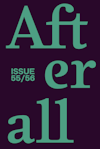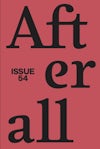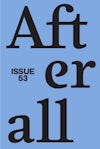
Issue 32
Spring 2013
Issue 32 looks at image-making through the work of Saloua Raouda Choucair, David Claerbout, Ahlam Shibli, James Welling and Pae White. Trevor Paglen discusses the limits of communication, while accompanying essays consider the images of the financial crisis and Pontus Hultén’s 1966 exhibition ‘HON’.
Editors: Nuria Enguita Mayo, Melissa Gronlund, Anders Kreuger, Pablo Lafuente, Stephanie Smith, Helena Vilalta.
Founding editors: Charles Esche, Mark Lewis.
Table of contents
Foreword
Contextual Essays
- ‘Friends of Space, How Are You All? Have You Eaten Yet?’ Or, Why Talk to Aliens Even if We Can’t – Trevor Paglen
- Stimulus, Austerity, Economy: Photography and the US Financial Crisis – Andrew Stefan Weiner
Artists
James Welling
- Welling’s ‘Wyeth’ – Caoimhín Mac Giolla Léith
- James Welling: The Mind on Fire
Saloua Raouda Choucair
- A Damaged Painting, A Shard of Glass: Discovering Saloua Raouda Choucair – Kaelen Wilson-Goldie
Pae White
- Summer Work: The Art of Pae White – Glenn Adamson
- Pae White’s Welcome Climate Change – Terry R. Myers
David Claerbout
- David Claerbout’s Indecisive Moments – Erika Balsom
Ahlam Shibli
- Walls, No Bridges: The Relation Between Revealing and Disguising in Ahlam Shibli’s Photographic Practice – Christian Höller
- And My Shrine Is My Mother’s Salon: On Ahlam Shibli’s ‘Death’
Events, Works, Exhibitions
- ‘HON – en katedral’: Behind Pontus Hultén’s Theatre of Inclusiveness – Benoît Antille
Foreword
The Afterall editorial team was in Chicago last month for our first meeting there since Stephanie Smith and the University of Chicago Open Practice Committee and the Smart Museum formally joined the journal as editorial partners. We enjoyed three days of intensive meetings and discussions about art and writing and slowly put together the contents for an upcoming issue. Our debates culminated in a quite animated moment when we met for a final time at the Arts Club of Chicago. The discussion came down to the question of whether or not depictive forms were receiving proper attention, not only in our journal but also in the (art) world more generally. My own opinion is that we are sometimes compelled by the excitement of works with strong backstory and context; and that depictive works struggle with backstory and context because as works of pure composition they have to leave these ‘behind’, often unwillingly, and can sometimes be resistant to strong curatorial ideas. The question of composition is central to thinking about and discussing pictures, and perhaps that can be a secondary consideration when we discuss works where it is necessary to think about contextual elements. A picture is an extraordinarily modest thing and in that regard good pictures can only really speak for themselves — if they are not good pictures there is nothing else for them to be good at. Clearly all of this is a little caricatured, but it’s an argument around which two sides might naturally want to disagree, and we did.
In his extraordinary new novel Canada (2012), Richard Ford, in the middle of a description of a dramatic event, quotes Ruskin defining composition as the bringing together of unequal things. This nod to art history and criticism can certainly be read as a moment of authorial self-reflection. Indeed in a recent interview Ford describes how his novels begin with the accumulation of data and notes, kept piled high on his desk or arranged on index cards as in a catalogue, and that slowly, through a kind of montage familiar to artists, are assembled, edited and sewn together to make the story that you eventually read. In other words, Ford’s novel, like picture-making, is the result of a material process, a forming via addition, subtraction, substitution and erasure until the composition feels right. But re-composition (and indeed decomposition) is also what happens when a reader reads a text or when a viewer looks at a picture: he or she begins the very same process all over again, of addition, subtraction and so on in order that he or she may remake the work as if he or she were the author or the artist. Composition then is not just the way a picture or text is made; it is also something that the reader or viewer feels — the apparent seamlessness of a work rubs up against the fact of its having been made, of having been put together out of unequal things. And obviously this double force of composition is embodied and felt differently depending on the kind of work, or the type of materials from which the latter is formed. Essentially, though, the beauty of an image’s composition is achieved in how it manages and conjures the estrangement and absence of context, backstory and intentionality, as much as through its ostensible attempts to use these very same things as opportunities for pictorial forms. Composition, then, is what can make a depiction feel as if it were hovering on the abyss of decomposition, doubt or incoherence.
Purchase
The publication is available for purchase. If you would like specific articles only, it is also available individually and to be downloaded as PDFs.
Purchase full publication
Buy via University of Chicago Press
Buy via Central Books
Purchase individual articles
Buy via University of Chicago Press



